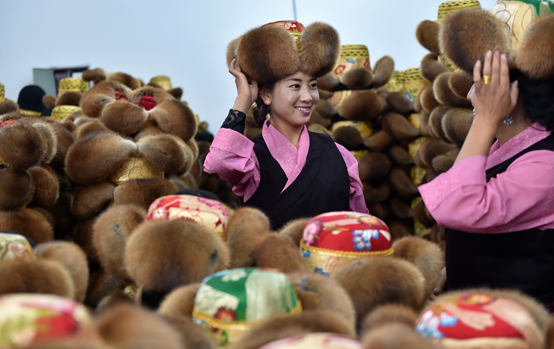

Poverty alleviation was a highlight of the development of southwest China’s Tibet Autonomous Region with GDP growth by 9.1 percent in 2018.

Two Tibetan women try hats at a hat factory in Dranang county, Shannan, Oct. 9, 2018. The factory, established in 2013, employs 45 local villagers from impoverished households and surplus rural laborers. The workers earn more than 6,500 yuan on average per month. As the products of the factory are well-received by the market, this year, the factory plans to recruit more people, which means more job opportunities for impoverished farmers and herders. (Photo by Xinhua News Agency)?
Statistics indicated that a total of 181,000 people and 25 impoverished counties in the region were lifted out of poverty over the past year.
Tsering Tsoten is a deputy to the 13th National People’s Congress from a village in Biru county, Nagqu city of northern Tibet. The village, located at an altitude of 4,300 meters, suffers from harsh natural conditions.
Now, the village is connected to hardened roads, stable electricity, and clean water supply. In 2018, the per capita income of farmers and herdersin the village reached 13,300 yuan ( $1,981), marking complete elimination of poverty.
In 2018, over 200 major growers and poultry farmers, 80 agricultural enterprises, as well as 1,000 skilled people from inland regions came to Tibet Autonomous Region and offered technical assistance for 3,000 local farmers under the encouragement of Tibet government. In addition, a group of people who have grown rich were also invited to share their experiences.
This year, Tibet Autonomous Region is planning to increase farmers’ income by 13 percent.
 Fire brigade in Shanghai holds group wedding
Fire brigade in Shanghai holds group wedding Tourists enjoy ice sculptures in Datan Town, north China
Tourists enjoy ice sculptures in Datan Town, north China Sunset scenery of Dayan Pagoda in Xi'an
Sunset scenery of Dayan Pagoda in Xi'an Tourists have fun at scenic spot in Nanlong Town, NW China
Tourists have fun at scenic spot in Nanlong Town, NW China Harbin attracts tourists by making best use of ice in winter
Harbin attracts tourists by making best use of ice in winter In pics: FIS Alpine Ski Women's World Cup Slalom
In pics: FIS Alpine Ski Women's World Cup Slalom Black-necked cranes rest at reservoir in Lhunzhub County, Lhasa
Black-necked cranes rest at reservoir in Lhunzhub County, Lhasa China's FAST telescope will be available to foreign scientists in April
China's FAST telescope will be available to foreign scientists in April "She power" plays indispensable role in poverty alleviation
"She power" plays indispensable role in poverty alleviation Top 10 world news events of People's Daily in 2020
Top 10 world news events of People's Daily in 2020 Top 10 China news events of People's Daily in 2020
Top 10 China news events of People's Daily in 2020 Top 10 media buzzwords of 2020
Top 10 media buzzwords of 2020 Year-ender:10 major tourism stories of 2020
Year-ender:10 major tourism stories of 2020 No interference in Venezuelan issues
No interference in Venezuelan issues
 Biz prepares for trade spat
Biz prepares for trade spat
 Broadcasting Continent
Broadcasting Continent Australia wins Chinese CEOs as US loses
Australia wins Chinese CEOs as US loses